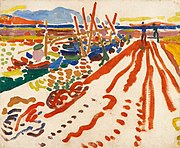
Fauvism
Fauvism (/foʊvɪzəm/) is a style of painting and an art movement that emerged in France at the beginning of the 20th century. It was the style of les Fauves (French for the wild beasts), a group of modern artists whose works emphasized painterly qualities and strong colour over the representational or realistic values retained by Impressionism. While Fauvism as a style began around 1904 and continued beyond 1910, the movement as such lasted only a few years, 1905–1908, and had three exhibitions.[1][2] The leaders of the movement were André Derain and Henri Matisse.
Artists and style[edit]
Besides Matisse and Derain, other artists included Robert Deborne, Albert Marquet, Charles Camoin, Bela Czobel, Louis Valtat, Jean Puy, Maurice de Vlaminck, Henri Manguin, Raoul Dufy, Othon Friesz, Georges Rouault, Jean Metzinger, Kees van Dongen, Émilie Charmy and Georges Braque (subsequently Picasso's partner in Cubism).[1]
The paintings of the Fauves were characterized by seemingly wild brush work and strident colors, while their subject matter had a high degree of simplification and abstraction.[3] Fauvism can be classified as an extreme development of Van Gogh's Post-Impressionism fused with the pointillism of Seurat[3] and other Neo-Impressionist painters, in particular Paul Signac. Other key influences were Paul Cézanne[4] and Paul Gauguin, whose employment of areas of saturated color—notably in paintings from Tahiti—strongly influenced Derain's work at Collioure in 1905.[5] In 1888 Gauguin had said to Paul Sérusier:[6]
"How do you see these trees? They are yellow. So, put in yellow; this shadow, rather blue, paint it with pure ultramarine; these red leaves? Put in vermilion."
Fauvism has been compared to Expressionism, both in its use of pure color and unconstrained brushwork.[3] Some of the Fauves were among the first avant-garde artists to collect and study African and Oceanic art, alongside other forms of non-Western and folk art, leading several Fauves toward the development of Cubism.[7]







![Georges Braque, 1906, L'Olivier près de l'Estaque (The Olive tree near l'Estaque). At least four versions of this scene were painted by Braque, one of which was stolen from the Musée d'Art Moderne de la Ville de Paris during the month of May 2010.[25]](http://upload.wikimedia.org/wikipedia/en/thumb/3/37/Georges_Braque%2C_1906%2C_L%27Olivier_pr%C3%A8s_de_l%27Estaque_%28The_Olive_tree_near_l%27Estaque%29.jpg/180px-Georges_Braque%2C_1906%2C_L%27Olivier_pr%C3%A8s_de_l%27Estaque_%28The_Olive_tree_near_l%27Estaque%29.jpg)








